
Welcome to the second look at the history of Batman in animation. (To read Part 1, click here.) Buckle up, because here’s where it gets really good!
In the latter 1980s, syndicated cartoons underwent a huge transformation, as studios shifted away from toy-driven shows to more high-quality programs with bigger budgets and intentions to appeal to all ages, even adults. Disney kicked things off with Duck Tales and Warner Bros. followed suit with Tiny Toon Adventures and Animaniacs. These shows were bright in tone and comedic. Some of the humor was deemed TOO adult as some episodes of Animaniacs were later pulled for being too racy for children.
Comic books underwent a major change during the same time, and sort of in the same direction. Among the biggest releases of this period was Frank Miller’s The Dark Knight Returns, a mature, gritty interpretation of an older Batman who comes out of retirement to save Gotham from a roving gang of mutants.
Miller’s take on Batman was not only wildly successful but incredibly influential. Warner Bros. had been developing a Batman movie for years, but once The Dark Knight was released, things really kicked into high gear. Tim Burton wound up directing the live-action theatrical film Batman which went on to become the highest-grossing movie of 1989. Burton then directed the sequel Batman Returns which hit theaters in 1992. Both movies borrowed tonal elements from Miller’s work.
These movies also opened the door for Batman: The Animated Series.
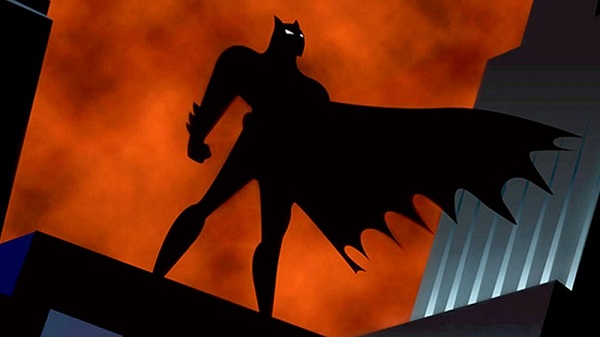
This series drew from the early days of the Batman comic books, with a distinct film noir style, influenced by the Fleischer Superman theatrical shorts. The retro art was devised by Bruce Timm and Eric Radomski, although it mashed up eras. The clothing and vehicles were straight out of the 1940s, but there were modern computers and other technologies.
Radomski designed the overall look of this Gotham City and came up with the idea to paint the art on black backgrounds, whereas every other cartoon up to this point had been painted on white paper. His mixture of film noir and Art Deco was dubbed “Dark Deco” by the artists that worked on the series.
Timm designed the characters, giving them a clean, sleek style reminiscent of the Fleischer cartoons as well as Alex Toth’s for the early Hanna-Barbera series.
Timm developed the program along with Paul Dini and Mitch Brian. Many episodes adapted stories from the comics, while others were original. The show was an immediate hit. Entertainment Weekly named it as one of the Top 10 shows of the year when it debuted and it went on to earn five Emmy Awards.
It initially aired on weekdays on FOX affiliates. 65 episodes were created for the first season which was spread out over two years. In its second official season, the show aired new episodes on Saturday mornings.
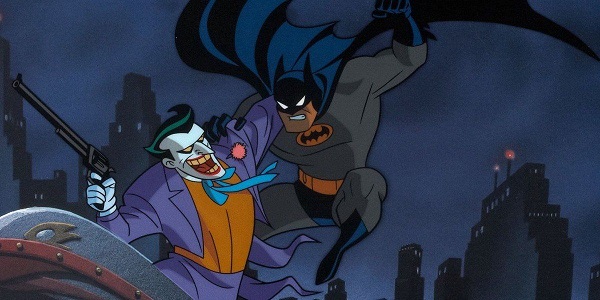
Kevin Conroy voiced Batman/Bruce Wayne while Mark Hammil voiced The Joker. For many fans, these are the definitive portrayals of these characters in any medium. Conroy differentiated his vocal performance as Bruce Wayne from that of Batman, something he modeled after the 1934 film The Scarlet Pimpernel and was also used by Michael Keaton in his Batman films and in subsequent portrayals.
Tim Curry (The Rocky Horror Picture Show) was originally hired to voice The Joker and recorded some episodes before coming down with bronchitis. Hammil had voiced a random criminal on the show and was tapped to play The Joker after Curry became unavailable. Hammil says that his famous Joker laugh was honed during his time starring in a stage version of Amadeus.
Andrea Romano served as the vocal director of B:TAS and later DC animated programs. She preferred to have the actors record together which was a rarity at the time. Usually, actors would simply record their parts separately and then have them mixed together.
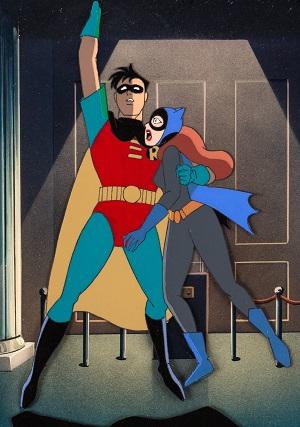
Initially, the creators of B:TAS wanted to only focus on the titular character, but FOX demanded sidekicks to appeal to a broader audience. As a result, Robin (voiced by Loren Zlester) and Batgirl (Melissa Gilbert) were included sporadically at first, then more often in later seasons.
The Robin depicted was Dick Grayson, although he wore the costume that had recently been introduced in the comics for the third Robin, Tim Drake.
On B:TAS, Dick Grayson and Barbara Gordon were friends and attended the same college, but did not know each other’s secret identities.
In addition to adapting stories from the comics, the program also borrowed from Burton’s movies. The Joker’s real name was stated to be Jack Napier, the name that Jack Nicholson’s Joker had in the first film, although in later episodes that was dismissed as an alias. The Penguin (Paul Williams) was a mutant like Danny DeVito’s version in Batman Returns. Similarly, that changed in later episodes, after that sequel had faded, when the character was redesigned to resemble the classic comic book character.
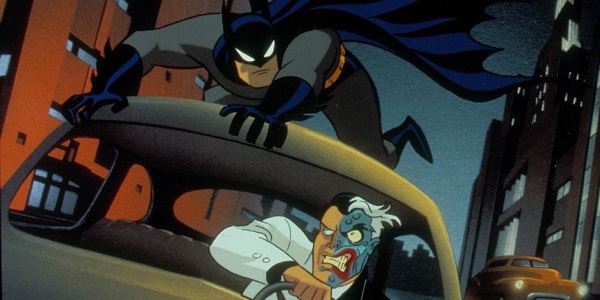
WB courted Al Pacino to voice Two-Face but he declined. Richard Moll landed the role. Clive Revill provided the voice of Alfred Pennyworth for the first three produced episodes, but Efrem Zimbalist Jr. took over after that. Bob Hastings voiced Commissioner Gordon with Robert Costanzo as Detective Harvey Bullock.
The villainous voice cast included Adrienne Barbeau as Catwoman, John Vernon as Rupert Thorne, John Glover as The Riddler, Diane Pershing as Poison Ivy, Henry Polic II as Scarecrow, Roddy McDowall as the Mad Hatter, Aron Kincaid as Killer Croc, Ron Perlman as Clayface, David Warner as Ra’s al Ghul, Michael Ansara as Mr. Freeze, Marc Singer as Kirk Langstrom/Man-Bat, George Dzundza as the Ventriloquist and Scarface, Ed Asner as Roland Daggett, Alan Rachins as Clock King, Henry Silva as Bane, Ray Buktenica as Hugo Strange, Treat Williams as Professor Milo, and Michael York as Count Vertigo.
TV’s live-action Batman, Adam West lent his voice to the fictional superhero The Gray Ghost. Theatrical’s Supergirl, Helen Slater, voiced Talia Al-Ghul.

B:TAS introduced several characters that were later added to the comics including the vigilante Lock-Up, former actor Simon Trent, brainwashed comedian-turned-supervillain Condiment King, and ninja Kyodai Ken. But two characters REALLY made a splash in other media.
Renee Montoya was introduced as Harvey Bullock’s partner. She was adapted into the comics and co-headlined the series G.C.P.D. She became one of the first out LGBTQ characters in comics. She had a lengthy romance with Kate Kane/Batwoman and eventually became a superhero herself, The Question.
Victoria Cartagena portrayed Montoya on Gotham and more recently played a different version of the same character on Batwoman. Rosie Perez played Montoya in the 2020 theatrical movie Birds of Prey.
On B:TAS, Ingrid Oliu voiced Montoya in Season 1, with Liane Schirmer taking over after that.
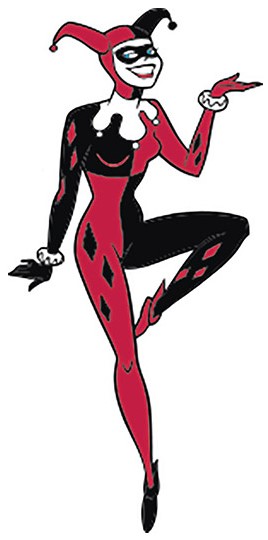
Even more successful was Harley Quinn. This character was based on the voice actor that portrayed her, Arleen Sorkin. Originally, this daffy moll of The Joker’s was only meant to appear in one episode, but to say she caught on with fans is an understatement.
Harley Quinn became a phenomenon. Not only was she adapted into the comics, but she also headlined her own series for years. She has been adapted into pretty much every form of media there is — other animated series and movies, video games, toys/collectibles, television, and film. She HAS to be the most cosplayed female character in all of fandom.
In 2002, Mia Sarah portrayed the first live-action version of Harley Quinn on the series Birds of Prey. Francesca Root-Dodson played a Harley-like character named Ecco on Gotham. Harley made a slight cameo in Arrow voiced by Tara Strong. Producers had hoped to feature the character more fully, but those plans were scrapped because of the Suicide Squad movie.
Speaking of, Margot Robbie has portrayed Harley in three feature films — Suicide Squad, Birds of Prey, and The Suicide Squad. She may appear in more DC films, as there are a few more projects that have been mentioned over the years including a twisted romance flick with Jared Leto’s Joker and a Gotham City Sirens film.
Most recently, DC Universe and HBO Max have released an adult-themed Harley Quinn animated series which has been critically acclaimed. Kaley Cuoco provides her voice in this series. Two seasons have been released and a third has been ordered.
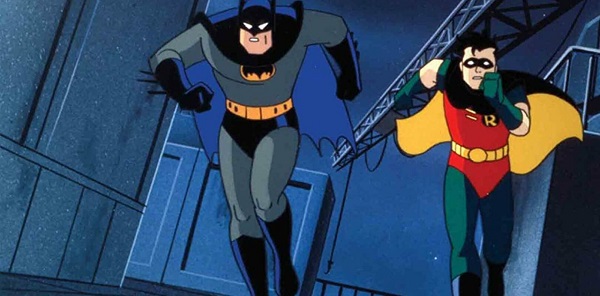
There were 65 episodes of B:TAS which is the minimum needed for a show to be syndicated. But it was such a hit that FOX ordered an additional 20 episodes for a second season which ran from 1994-95. These episodes aired on Saturday mornings. Robin was given a larger role and these episodes were broadcast as The Adventures of Batman & Robin.
In 1997, the show was once again reinvented as The New Batman Adventures. The blue portions of Batman’s costume were changed to black. The yellow oval on his chest was removed and his yellow utility belt was toned down.
Batgirl’s costume was darkened as well although she swapped out her blue gloves and boots for yellow. Dick Grayson graduated from Robin to Nightwing. Batman gained a new Robin, Tim Drake, who wore a newly designed costume that was later adapted to the comics. The art style overall was also modified to more closely match that of Superman: The Animated Series which had debuted in 1996 and was set in the same universe as B:TAS.
The New Batman Adventures was originally conceived of as Gotham Knights and would have also featured The Creeper in a recurring role. Ultimately, the character only appeared in one episode, “Beware the Creeper” voiced by Jeff Bennett. The character Etrigan the Demon (Billy Zane) also appeared.
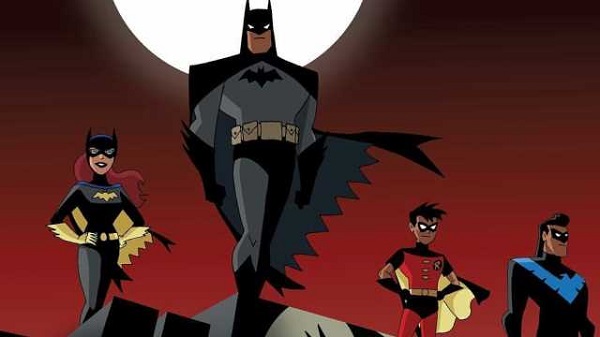
It was in this season that The Penguin was redesigned to more closely resemble the classic comic book version as opposed to the Danny DeVito film version. Ironically, Catwoman was redesigned and looked more like Michelle Pfeifer’s version from the same movie, Batman Returns. The Joker was given a simplified design minus his famous red lips.
This season also introduced a character, Roxy Rocket (Charity James), who was also adapted into the comics, although she is nowhere near as popular as Harley Quinn or even Renee Montoya.
This season also featured crossovers with Superman: The Animated Series and Static Shock!. In addition to having Batman and Superman join forces, there was an episode in which Batgirl and Supergirl teamed up against Catwoman, Harley Quinn, Poison Ivy, and Livewire.

There were a total of 24 episodes of The New Batman Adventures.
In 1993, a theatrical movie, Batman: Mask of the Phantasm was released, although it flopped at the box office. Despite that, this film is highly regarded and gained a following on home video.
Another animated movie, Batman & Mr. Freeze: Sub-Zero was created as a tie-in to the live-action theatrical film Batman & Robin, but after that movie disappointed, the animated film was shelved for approximately a year before it was finally released on home video in 1998.
The previous two films were created during the original B:TAS run and featured art and designs that reflected that. Another direct-to-video movie, 2003’s Batman: Mystery of the Batwoman was made during The New Batman Adventures era and featured the redesigned versions of the characters.
B:TAS and The New Batman Adventures aired on FOX initially. At the time, The New Batman Adventures was considered a separate series, although it is now simply seen as the third season of B:TAS. Reruns later aired on the Cartoon Network and Boomerang (both of which are owned by parent company Warner Brothers), then on The WB’s Saturday morning lineup, and later on Disney’s Jetix.
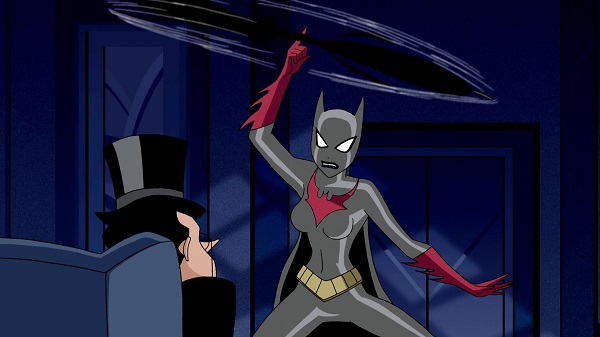
This version of Batman had a lengthy and successful run. Even so, WB wanted to keep the brand going, but it seems that the creative team had mostly told all the Batman stories they wanted to tell. Thus was born Batman Beyond (known as Batman of the Future in some countries).
Set in the far future of 2019 (wait, what?!), 20 years after B:TAS, this series featured an elderly Bruce Wayne (still voiced by Conroy) mentoring a new teenage champion, Terry McGinnis (Will Friedle) who wore a high tech Batsuit made with nanotechnology. This suit gave Terry powers that Bruce never had, including flight. Gotham is now known as Neo-Gotham. Wayne Enterprises has merged with another company to become Wayne-Powers. Because Bruce is now over 70 years old, the company is run by the shady Derek Powers (Sherman Howell).
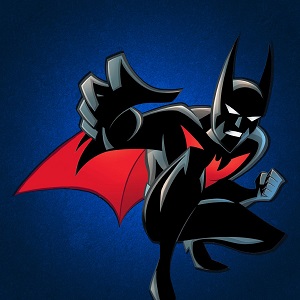
Alfred is deceased in this version, but Bruce is accompanied by a large Great Dane, Ace (Frank Welker). Barbara Gordon (originally Stockard Channing, later Angie Harmon) has replaced her father as the Neo-Gotham police commissioner.
Among Terry’s supporting cast are Max Gibson (Cree Summer) a super-smart classmate that discovers his dual identity and helps him out at times, and Dana Tan (Lauren Tom), his main love interest.
Most of Bruce’s old allies have either retired or are dead. The same goes for his classic foes. In the first episode, Terry runs afoul of a street gang called The Jokerz. Derek Powers transforms into the radioactive Blight. Among Terry’s other foes are the shapeshifting Inque, the hypnotic Spellbinder, supersonic Shriek, and the Royal Flush Gang. Some of Bruce’s old villains returned in modified forms including Mr. Freeze, Bane, and Ra’s al-Ghul.
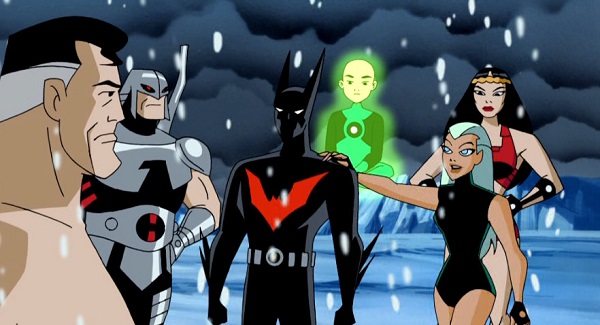
In the third season of Batman Beyond, the show’s creators finally got to do something that they had been hoping to do for years — introduce the Justice League. Known as Justice League Unlimited, this group included an older gray-haired version of Superman (Christopher McDonald), Warhawk (Peter Onorati, later revealed to be the son of Hawkgirl and Green Lantern/John Stewart), a young Asian boy version of Green Lantern (Lauren Tom), Aquagirl (Jodi Benson, the daughter of Aquaman and Mera), Micron (Wayne Brady, an African American successor to The Atom… wait, WAYNE BRADY?!), and the New God Big Barda (Farrah Forke). Barda was used because WB couldn’t legally use Wonder Woman at the time. Jodi Benson, who voiced Aquagirl, is perhaps better known for playing another aquatic hero, Disney’s Little Mermaid, Ariel.
Batman Beyond spawned a spin-off, the often forgotten Zeta Project. That series followed an android designed to kill that overcomes his programming and goes on the run from the government, accompanied by a teenage girl.
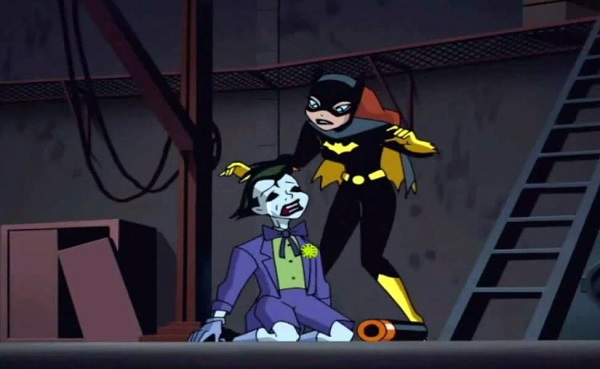
A direct-to-video movie, Batman Beyond: Return of the Joker was released in 2000, however, it arrived shortly after the Columbine High School shootings. As a result, this picture was deemed too violent for children and it was heavily edited. Word spread quickly online and after massive fan lobbying, WB released an uncut version in 2002. (Oh man, I just realized this was like the original “Release the Snyder Cut!”) In that film, it was revealed that The Joker had brutally tortured and brainwashed Tim Drake/Robin and even surgically altered him to look like The Joker. Once Batman and Batgirl located Tim, he kills The Joker while Harley Quinn falls into a ravine, presumably to her death. Tim’s brain is permanently damaged by the experience.
Ultimately, there were three seasons of Batman Beyond, adding up to 52 episodes with the last new episode airing in 2001.
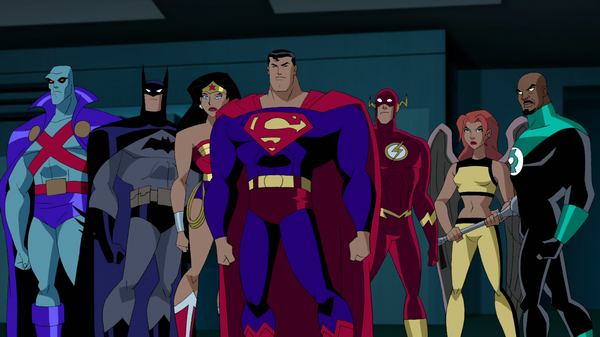
Throughout the runs of Batman: The Animated Series and Superman: The Animated Series, the shows’ creators pushed for a Justice League cartoon. Aquaman, The Flash, and the Hal Jordan version of Green Lantern guest-starred on Superman. As mentioned, due to legal issues, Wonder Woman could not be used as just a guest star. However, it appears there was a loophole that would allow WB to use her as a regular ongoing character.
In the fall of 2001, Justice League debuted with Conroy reprising the role of Batman. George Newburn replaced Tim Daley as Superman. The cast also featured Susan Eisenberg as Wonder Woman, Phil LaMarr as Green Lantern/John Stewart, Michael Rosenbaum as The Flash/Wally West, Carl Lumbly as Martian Manhunter, and Maria Canals-Barrera as Hawkgirl.
Originally, this was planned as an hour-long show with the pilot “Secret Origins” being an extended 90-minutes long, but when Cartoon Network aired it, it broke the show into 30-minute episodes, with the first part of each story ending in a cliffhanger.
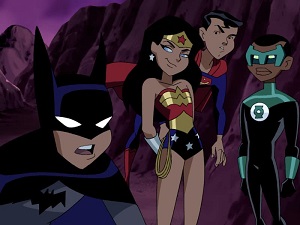
Unlike previous shows, Justice League aired on Cartoon Network during prime time. There were two seasons consisting of 52 episodes. Plans were in place to create a direct-to-video film after that, which would have revealed how Wonder Woman acquired her Invisible Jet and would have featured the Crime Syndicate, but this project was scrapped. If the plot sounds familiar, it’s because it was later reused for the film Justice League: Crisis on Two Earths, which was drawn in a different style and was not connected to the DC Animated Universe.
Though Justice League only lasted for two seasons, it was reinvented as Justice League Unlimited, the name used for the future League in Batman Beyond. These episodes were cut down to 30-minutes, but the team’s roster expanded massively with dozens of DC characters added, including The Creeper and Etrigan the Demon, who had previously appeared on B:TAS. Supergirl was also featured heavily, but due to other rights issues, Batman’s supporting characters Nightwing, Robin, and Batgirl never appeared, nor did the majority of his Rogue’s Gallery.
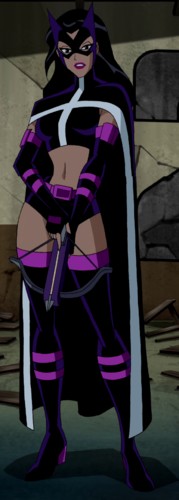
But another character, closely associated with the Dark Knight, The Huntress was added as a wildcard who wound up quitting the team, although she returned to help them when needed.
Another JLU character, Zatanna had previously appeared on B:TAS in which it was shown that she and Bruce Wayne had been romantically involved in their younger years. However, in JL it was teased that Batman and Wonder Woman had a romantic interest in one another. This was directly addressed in the JLU episode “This Little Piggy” in which Batman turns to Zatanna for help after Wonder Woman is turned into a pig by the sorceress Circe.
The 26th episode (13th of the second season), “Epilogue” was meant to not only wrap up JLU but also Batman Beyond with a story set in the future which revealed that Terry McGinnis was actually, biologically Bruce Wayne’s son.
However, Cartoon Network wasn’t done and placed an order for a third season. That season had Luthor assembling the Legion of Doom, the same name used for the villains on Super Friends. But to mirror the sprawling roster of the JLU, this group included dozens of villains, many of whom had previously appeared in past DC animated shows. By the end of the season, the heroes and villains had to work together to defeat Darkseid.
The last episode of JLU aired on May 13, 2006. Following this, WB moved on to new versions of Batman that were not connected to this expanded universe.
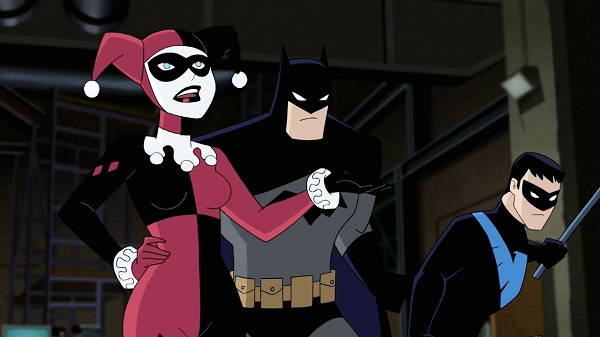
However, this continuity has been revisited in the years since the cancellation of JLU. In 2017, WB released Batman and Harley Quinn as a tie-in to the live-action Suicide Squad. This picture was released in theaters for one night only, then on DVD/Blu-Ray the week after.
In this picture, Batman (Conroy) and Nightwing (Lester) must team up with Harley Quinn (Melissa Rauch) to defeat Poison Ivy (Paget Brewster) and the Floronic Man/Jason Woodrue (Kevin Michael Richardson).
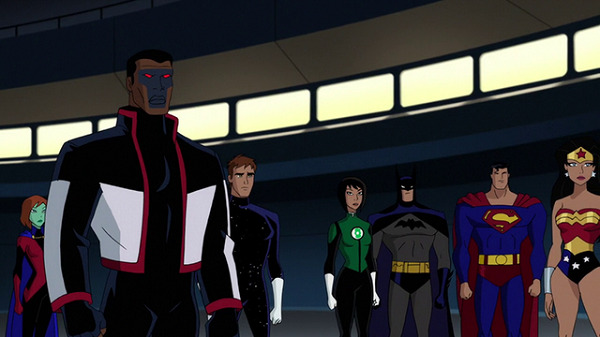
Most recently, this world was depicted in 2019’s Justice League Vs. The Fatal Five. Conroy, Newburn, and Eisenberg returned as Batman, Superman, and Wonder Woman, respectively. Kevin Michael Richardson voiced Mister Terrific, with Elyes Gabel as Star Boy, Diane Guerrero as Green Lantern/Jessica Cruz, and Daniela Bobadilla as Miss Martian.
This film had the team helping the Legion of Superheroes’ Star Boy to defeat their foes The Fatal Five with Sumalee Montano as Emerald Empress, Philip Anthony-Rodriguez as Mano, Peter Jessop as Tharok, and Matthew Yang King as The Persuader. (The fifth member, Validus, doesn’t speak.)
This film was not originally meant to be part of the DCEU, but was rendered that way to avoid confusion with the ongoing New 52-inspired DC animated movies that were coming out at the same time.
Overall, the DC Animated Universe was incredibly well-received by fans, and Batman: The Animated Series is considered one of the best cartoons of all time. Justice League and Justice League Unlimited are also beloved and the creators intentionally included references and Easter Eggs aimed directly at comic book readers.
While Batman went on to appear in more cartoons, it’s hard to imagine that any will ever make the impact that Batman: The Animated Series did.
What do you think? What is your favorite animated version of Batman?



